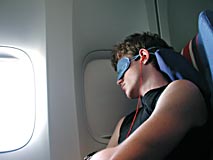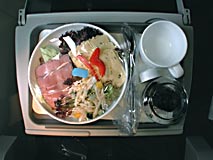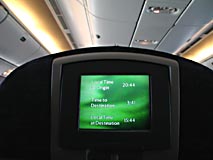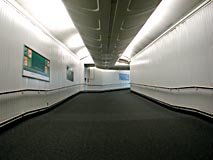Felix Stalder
[Essay written for the "zones" show by Thomas Kneubühler: (November 16 - December 14, 2002) at Observatoire 4 de Montréal - 372 rue Sainte-Catherine Ouest - Montréal - Québec - H3B 1A2 - tel. 514 866 5320]
[This essay has also been translated into French. The billigual brochure is can be downloaded as .pdf file]
 |
 |
 |
In "zones" photographer Thomas Kneubühler investigates airports, those pivotal points of contemporary experience where architecture creates spaces without places and jetlag separates bodies from souls. Airports are our cathedrals. Both represent enormous collective efforts devoted to the most central, most advanced institutions of their times. As little was we can imagine the Middle Ages without the church, as little can we imagine the present without airlines. Both medieval religion and air travel are mass phenomenona, essential to their culture offering an experience of disembodiment.
Virtually everyone who is not poor, ill or incarcerated is either on a trip or in between trips. More and more time is being spent in airports and other highly artificial spaces of transit. Thomas Kneubühler¹s digital photography reveals them as magnificent and hostile at the same time.
This ambivalence is indicative. Like churches, their magnificence radiates from their super-human size and dizzying complexity. Contrary to churches airports are also hostile. Even if we go there all the time, we are not supposed to be there. Churches are places of arrival, airports are spaces of departures. In a church, we are a collective congregation, on an airport, we are solitary passengers frantically heading towards the exit.
Airports are not places, they do not provide shelter, stability or identity. They are hubs in a network. There are not containers but conduits, essential elements of what sociologist Manuel Castells calls the space of flows. Their core logic is dominated by what they connect to, rather than by what they contain or by what surrounds them. Airports are measured not by how many people they can hold, but by how many can pass through and how many tons of cargo can be processed.
Airports constitute a distinct, coherent and self-contained spatial reality detached from traditional localities. They are zones rather than locales. International airports everywhere are virtually identical, using the same architectural elements, the same visual language, containing the same stores and food outlets, all in the service processing people and goods as efficiently as possible.
 |
 |
 |
However, just underneath the surface of efficient globalization, hidden in the folds of an ideology of uninterrupted flows, lurks a contradiction. Airports also serve a different function. They are privileged places for interrupting the flow of people and goods. Airports are not only places of solitary, fleeting anonymity, but also of intense institutionalized surveillance where we are forced to stop, to reconnect with some "stable" referent. Nowhere is the accident of nationality more frequently affirmed than in the de-localized space of international airports.
Airplanes have been a preferred site for terrorists ever since the Palestinians began hijackings in the 1970s. On September 11, this reality reached North America. Ever since then, airports around the world are strained by their internal contradiction: to move and arrest.
Nevertheless, airports are booming. Within their perimeters, new cities are emerging, cities that have no connection to those that gave their names to them. They serve primarily as hub for the growing international population that architect Rem Koolhaas calls the kinetic elite. With that, we are coming full circle: transit as destination.